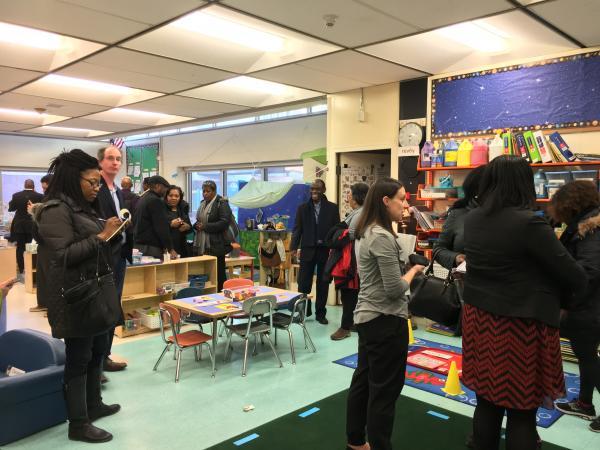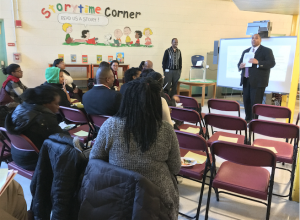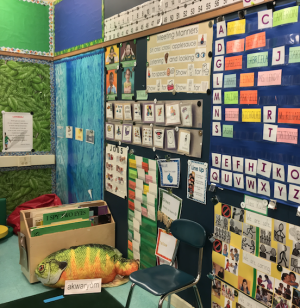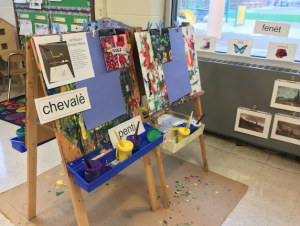March 23, 2017

Parents and school officials tour a model classroom for the Mattapan Early Elementary School dual language program. Jennifer Smith photo
Parents of prospective students got a first look at the new K1 dual language Haitian Creole program at the Mattahunt school on Wednesday night.
The program, which would roll out with the opening of the new Mattapan Early Elementary School for the 2017/2018 school year, will consist of one class in which one-third of the students speak Haitian Creole as a first language and at least one-third speak English.
These 25 students would enter a class schedule program in which 70 percent of the instruction time is taught in Haitian Creole and 30 percent in English. Boston Public School officials say it is likely the first two-way immersion Haitian Creole dual language preschool program in the country.
“Success is the only option,” said Mattahunt principal Walter Henderson, who will be continuing on in his role at the new Mattapan school. Principal Walter Henderson talks about the dual language program at an open house Wednesday night. Jennifer Smith photo
Principal Walter Henderson talks about the dual language program at an open house Wednesday night. Jennifer Smith photo
With students struggling to immerse themselves in a new language, especially the 4-year-olds the program is geared toward, a patient and engaging instructional staff is paramount.
“Our job is to build their self-esteem and their confidence to be great,” Henderson said. “So we’re practicing empathy; all of our teachers are going to be trained to be empathetic and culturally responsive to all the students needs. As well as empowering. We want to empower the children to advocates to themselves, so they can go back and be ambassadors, and lawyers and doctors wherever they want to be. We want to help the children have the courage to speak up for themselves.”
The program would last a normal K1 School day, filled with group activities, storytimes, melded math and language lessons, and physical education interspersed with the requisite meals, snack times, and rest periods.
“It’s a very busy, engaging day,” said Abby Morales, program director at Boston Public Schools. “They’ll come home ready to drop.”
Visitors explored a model classroom, which would look familiar to any parent with young children with one notable exception: cards with words in Haitian Creole tagged objects around the brightly-colored area. “Bifèt” hung on a cabinet, “tab” sat on a table, “akwaryòm” lay beside a large plush fish. The classrooms will also have English labels, instructors said.
 The inside of the model classroom includes Haitian Creole labeling throughout. Jennifer Smith photo
The inside of the model classroom includes Haitian Creole labeling throughout. Jennifer Smith photo
 A painting area in the model classroom
A painting area in the model classroom
Edyne Lalanne, 31, said she registered her 3-year-old daughter for the K1 dual language program.
“I am Haitian, I come from a first generation immigrant family,” Lalanne said. “My husband and I both speak Creole and English at home. Our Creole is shaky, at best, but we haven’t found a way to teach our children how to speak creole, we just haven't been able to bridge that gap.”
The program seemed like a strong way to get the language ball rolling, Lalanne said.
There will be a later open house or orientation just for enrolled families.
Michel DeGraff, with the MIT linguistics department, told the group that there are myriad advantages to choosing a Haitian Creole dual language program for their young children.
“Think of [the] Mattahunt [program] as being the wave of the future,” DeGraff said, “not just for Haiti, but for the world, in terms of how, here in Mattapan, we can use the dual language program to break walls -- which is now a radical statement. We want to break walls and build bridges to Mattapan.”
With a higher concentration of Haitian residents in Mattapan, speaking Haitian Creole can connect children with the community, he said. Demand for Haitian Creole speakers is rising in several fields.
Though historically maligned as a more difficult language or inferior to languages like French or Spanish, DeGraff said attitudes are changing.
Phonetically, it is a simpler language to learn than French, he noted. Just the pronunciation of the sound /o/, as in “oh,” is written in one clear way in Creole. French, however, has 40 different ways to spell that same sound.
“Why would you ever think Creole is difficult to write?’ he asked. “In fact, Creole is easy to write. What you need is to free your mind and accept the language.”
Mattapan resident Sarema Monroe, 25, attended the meeting to consider the program for her 4-year-old daughter. The presentation helped assuage several concerns she had regarding her English-speaking daughter’s participation in the dual language course.
“I thought it was pretty great,” she said of the presentation as she walked to gather her daughter from the childcare area. “And it actually gave me a lot of insight that I never realized as far as, I thought Haitian Creole was French. I thought it was broken French, like in the Caribbean it’s broken English, but that presentation basically debunked my whole analogy and everything I’ve thought my whole life.”
Monroe does still have some concerns about the 70-30 teaching ratio for predominantly English-speaking students.
One parent asked officials if the program would be looking at a longer-term plan, especially as it hopes to expand to K-5 or K-6 in the future. She also wanted to know if the administration would be encouraging and welcoming to parent engagement.
“We know that we can’t do it alone,” said assistant principal Joelle Gamere, “so this is just initiating the process, putting out to you what our goals are, but we can’t achieve our goals without partnership. So, yes, we do want to have a crystallized five- to ten-year plan, but we do know there are experts in this room that we can work with as a think tank to make that happen. It would be very disingenuous of us to just create a plan without incorporating the community as part of that plan”
The Boston School Committee voted that evening on a $1.061 billion Boston Public Schools budget, which could rise another $20 million after employee collective bargaining. The 5-2 vote sends the budget to the Boston City Council for approval.
The proposed budget notes a $6 million complete cut to the Mattahunt Elementary School, which is closing down on June 30 and immediately re-opening as the Mattapan Early Elementary School on July 1, budgeted for $3.9 million.
Villages:
Topics:


